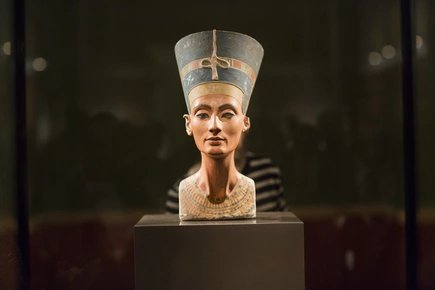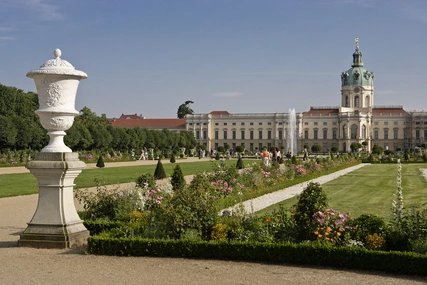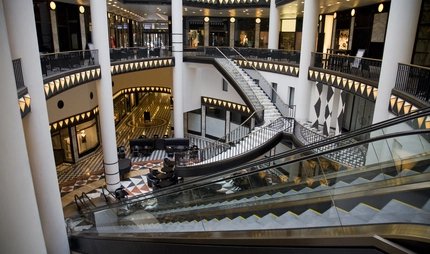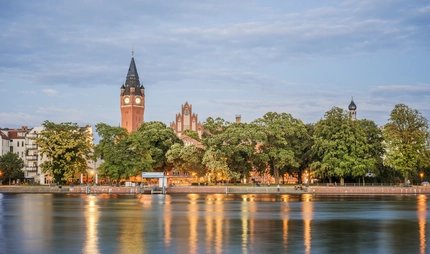
From the founding of Berlin (1183) to Queen Luise († 1810)
Medieval trading town
Despite the discovery in 2008 by city archaeologists of oak timbers at Petriplatz that probably date back to 1183, the official founding of Berlin took place in 1237. The unification of the two merchant settlements of Cölln and Berlin led to the creation of a “double town” containing by the year 1400 a population of about 8,500, some 1,100 buildings as well as three town halls. The first of these town halls stood on the site of the northwest corner of today’s Berlin Town Hall. Up to the beginning of the 15th century, Berlin (as well as Brandenburg) was subject to the authority of the Houses of Ascania (1157 - 1320), Wittelsbach (1323 - 1373) and Luxemburg (1373 - 1415).
Hohenzollern Berlin
1415 marked the beginning of the more than 500-year continuous domination of the Hohenzollern dynasty over Berlin, starting with Frederick I, Elector and Margrave of Brandenburg (1415 - 1440) through to Wilhelm II (1888 - 1918), then from 1701 as “Kings in Prussia”, and then from 1772 following the annexation of Polish Prussian territory as “Kings of Prussia” plus from 1871 with the additional title of German Kaiser. The Elector Frederick II (1440 - 1471) laid the foundation stone for the subsequent Berlin Stadtschloss (City Palace) on the Cölln Spreeinsel (Island in the Spree), which under the Elector Johann Cicero (1486 - 1499) became the permanent residence of the Hohenzollern dynasty in Brandenburg. The growing political and economic influence of Berlin was supported by the avowal of the Brandenburg Electors to the Reformation (1539) as well as by the settling of Jewish and Huguenot communities during the rule of the Great Elector Frederick Wilhelm (the Potsdam Edict of Tolerance in 1685). These confessional and political structural measures paved the way for the development of Berlin as a city of cultural diversity.
Royal Capital
Frederick I.
Today’s Charlottenburg Palace dates back to the Elector Frederick III (1688 - 1713), who built it for his wife Sophie Charlotte of Lietzenburg. In 1709, as “King in Prussia”, Frederick I united the towns of Berlin, Cölln, Friedrichswerder, Dorotheenstadt and Friedrichsstadt into the capital and royal city of Berlin. On his orders, a “pestilence house” was set up outside the city walls for the now 55,000 inhabitants, which his successor Frederick Wilhelm II in 1727 had converted into a sick bay together with a medical training school and gave it the name Charité.
Frederick the Great

Born in the Berlin Stadtschloss, Old Fritz (as he was referred to in his later years) ruled Prussia with an enlightened absolutism. He brought Prussia three wars, which resulted in the country becoming a European Great Power. In 1763, he founded the Königliche Porzellan-Manufaktur Berlin (Royal Porcelain Manufacture) and built the Neues Palais (New Palace) in Postdam. During Frederick’s regency, a representative architecture emerged in Berlin, which even today is still preserved in Unter den Linden. The Zeughaus (Armoury) (1706 / finally completed in 1730), Kronprinzenpalais (Crown Prince Palace) (1633 / converted in 1732), Prinzessinnenpalais (Princesses’ Palace) (1737, today’s Opera Palace), State Opera House (1742), Prince Heinrich Palace (1756, since 1810 the Humboldt University), St. Hedwig’s Cathedral (1773) and the Alte Bibliothek (Old Library) (1780) together create a baroque ensemble of buildings.
Salon Culture
Following the Seven Year’s War, the first artistic and literary salons sprang up on the French model. Men of letters such as Herder, Wieland, Goethe or Jean Paul, but also civil servants of the stature of Freiherr von Stein, gathered in the salons of ladies of society such as Karoline Friederike von Berg for the purpose of intellectual exchanges. The Jewish salons of Henriette Herz or Rahel Levins also permitted women such as Henriette Mendelsohn, Sophie Mereau-Brentano and Bettina von Arnim to meet with scientists of the reputation of Alexander and Wilhelm von Humboldt or members of the aristocracy such as Prince Louis Ferdinand of Prussia. By this means, affluent Jewish families were able to use the path of social acceptance to bypass their exclusion from society life and thus enjoy an increasing emancipation.
Queen Luise

Luise von Mecklenburg-Strelitz attained a cult status during her own lifetime. As Queen Louise, she attracted and won over people thanks to her beauty and unconventional nature. She enjoyed direct access to contemporary literature from Goethe, Herder, Jean Paul – among many others, via one of her court ladies, Mrs. von Berg, who hosted a famous literary salon in Berlin’s Tiergarten. Following the defeat of Prussia, in the Prussian town of Tilsit on the Russian border Queen Luise surrendered to Napoleon personally with her head held up high and requested moderate peace terms from the Frenchman. Her tomb in the Charlottenburg Palace Gardens is a memorial to the woman, who bore 10 children into the world and died in 1810 at the early age of thirty-five, and has remained ever since a pilgrimage shrine for her numerous admirers.



